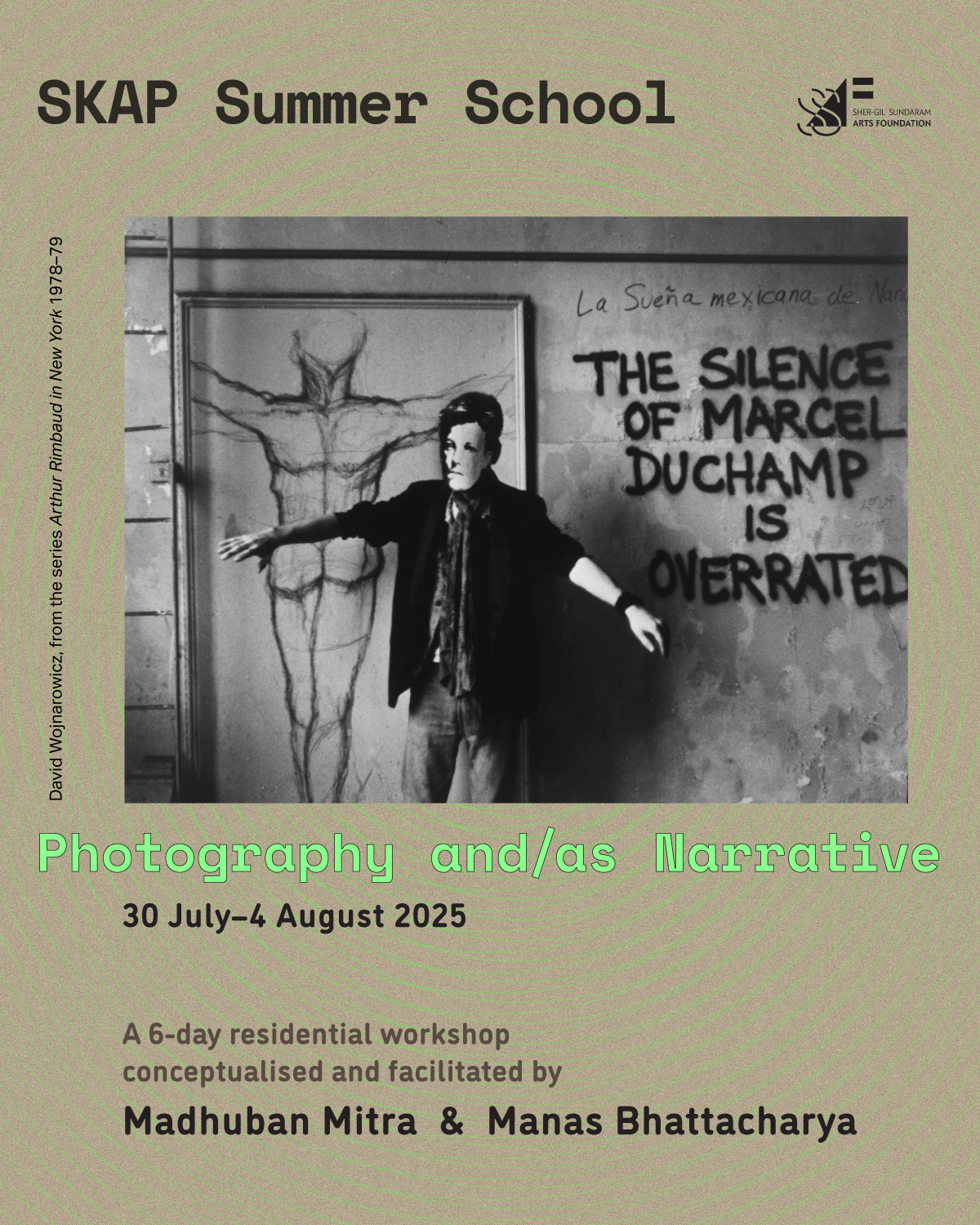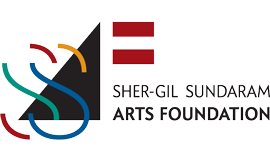Conceptualised and facilitated by Madhuban Mitra & Manas Bhattacharya
30 July–4 August

As the quintessential 21st century medium, photography is everywhere, everything is photography (from photographs taken by the Hubble Space Telescope to an MRI scan of the human brain) and everyone is a photographer. One of the enduring myths about photography is that it is always “about” something. In our own context, photography is almost never allowed to be itself without being yoked to some kind of function or message. Though artists have, more often than not, used photography in ways other than the functional and the informational, the dominant perception remains largely unshaken. Such a deeply conservative, one-sided view of an eclectic and generous medium comes primarily from the throttlehold of news media, photo agencies, and more generally the information empire to which photography was hitched early on, as well as its extensive use value. Why is it that photographs have to describe or illustrate something or ought to, like the climate crisis or identity politics? Ironically, photography is neither an efficient nor a reliable medium of description or illustration, yet it has been consistently pressed into serving such agendas.
What if we shift the vantage, eschew verisimilitude, indexicality, evidentiality, topicality, didacticism and dozens of other burdens photography has borne, and look at its other histories, rather at ideas, attitudes and practices that tap the unique properties of a medium that is expansive, nimble and resilient if freed from all prescriptions and projections? What if we allowed photographs to lie rather than show and tell the truth? Regarded as such, photography approaches its sister medium cinema and builds bridges with the other arts like painting, sculpture or literature.
The workshop will consider the different ways in which photography, often conventionally understood as embodying single, more or less autonomous images, can approach narrative. The term narrative is often misunderstood, and or used interchangeably with story. Studies of narrative and narrativity, primarily within literary studies, make for a nuanced understanding of why story and narrative, though enmeshed, are different: the “what” of the story as distinct from the “how” of narrative. Narrative is not to be confused with ‘photo story’ as defined by magazine reportage or editorial photography. We will explore the history of photography as narrative in its fiction, hybrid, semi-fiction and non-fiction variations. This entails a deep dive into a range of pivotal narrative photographic projects made in the last sixty years in different parts of the world, for instance the Photo-roman/Photo-Novel form or photo-fictions that use the photographic sequence as opposed to the single staged photograph. There is a loose, somewhat arbitrary conglomeration of single images posing as “poetic” narrative quite rampant in the photography world, especially in the form of photo books, which is not under consideration here. Rather, the workshop will place particular emphasis on ideas of sequentiality, montage, cinematicity, narrative structure and various modes of staging. The discussion will also focus on how the notion of the cinematic in photo narratives, a kind of “paper cinema”, functions in ways different from cinema, with which it obviously has the closest kinship. Image-text narrative works, combining photography with writing/literature would be another focal point. When there is a text/literary component, how does it shape and interact with the visual component, as opposed to fully visual photo narratives?
Instead of lectures recycling theory in the abstract, the workshop envisages a deep, participatory engagement with practices and works through which different modes and strategies of working with photography and narrative can be illuminated. For example, we will look closely at how ideas of self-portraiture, performativity and cinematicity intersect with gender politics and the city-as-stage in the narrative work of artists as different as David Wojnarowicz and Pushpamala N. We will examine how the categories like personal and political, subject and object, observer and observed, or documentary and fiction dissolve in the photo-narrative works of Allan Sekula, Sophie Calle, Duane Michals or Lynn Hershman-Leeson, or how fictional archives are set in motion to interrogate the document, history and notions of truth in the work of Joan Fontcuberta or Zoe Leonard.
Facilitators
Manas Bhattacharya and Madhuban Mitra have been working together as an artist duo for the last decade and half, primarily with photography, film and video and more recently, Artificial Intelligence. Madhuban studied English Literature and holds a Ph.D in Cultural Studies. Manas studied Cinematography after completing a Masters in Comparative Literature. Their practice probes the nature of images and their relationship to society, politics and technology, with a particular interest in how history and memory both shape, and in turn are shaped by images. Often driven by extensive research, their work oscillates between and often combines documentary and fiction, analogue and digital, images made and found, still and moving, abstraction and figuration. Their work resides in the permanent collections of the Kiran Nadar Museum of Art (KNMA), Museum of Contemporary Photography (MoCP) Chicago, Fondazione MAST, Bologna, and private collections around the world. They conceived and developed the curriculum for courses they taught as visiting faculty in the Masters programme in Photography at the National Institute of Design (NID), Gandhinagar, between 2017-2022.
Participants
Akshay Bhoan is a lens-based artist. He completed his MFA from Slade School of Fine Art, London in 2023.
Ankur Yadav is an artist living and working in Behror. He completed his MVA in Painting from Maharaja Sayajirao University Baroda in 2019.
Aritra Dey is an artist from Kolkata, currently pursuing his MFA in Printmaking from Sarojini Naidu College of Arts and Communications, Department of Fine Arts, University of Hyderabad.
Diksha Gupta is a photographer based in Indore. She completed her BSc in Electronic Media from Educational Multimedia Research Centre in 2022.
Joseph Lawrence lives and works in Kottapadi. He completed his MA Visual Art from Dr. B.R. Ambedkar University New Delhi in 2023.
Kaamna Patel is a visual artist and founder of the publishing imprint Editions JOJO, and currently based in Mumbai. She completed her BFA in Photography from Parsons Paris/Paris College of Art in 2014.
Karno Dasgupta is a writer and researcher. He finished his MA in Global Studies/International Relations (Dual Program) from Bard College and Central European University in 2024.
Kirti Kumari is a photographer and visual researcher from Kanpur. She completed her MDes. in Photography from the National Institute of Design in 2019.
Kulsoom Javed is a visual artist based in New Delhi. She completed her MA Visual Art from Dr. B.R. Ambedkar University New Delhi in 2024.
Manon Gangopadhyay is an artist from Kolkata. He finished his BVA in Painting from Maharaja Sayajirao University Baroda in 2025.
Mritunjay Kumar is a self-trained photographer, currently based in Bengaluru.
Samira Bose is a writer and curator. She completed her MA in Arts and Aesthetics from Jawaharlal Nehru University, New Delhi in 2018.
Shreya Wankhede is a photographer based in Mumbai. She completed her studies at the Dharagaon College of Arts, Commerce and Science in 2013.
Shubhdeep Kaur is a photographer based in New Delhi. She completed her PG Diploma in Photography from Sri Aurobindo Centre for Arts and Communication in 2021.
Somudra Banerjee is a filmmaker and writer. He completed his PG Diploma in Film Direction & Screenwriting from the Film and Television Institute of India, Pune in 2023.
Sukanya Deb is a writer and curator based in New Delhi. She is the founder-editor of pureemag.com. She finished her MA in Cultural Studies from Goldsmiths College, University of London in 2017.
A note from the facilitators—
“We are elated to share that we received an overwhelming response to the call for the first workshop of the Summer School, quite beyond our expectations. We received a total of 119 applications from people with remarkably diverse backgrounds and pursuits, transcending the narrow confines of practice defined by any single discipline or medium. Since we had only 16 places to offer, our task of selecting and arriving at the final list of participants was particularly difficult. This meant we could not accommodate many applicants whose work or inquiries were interesting and inspiring, and who we would have liked to have as participants, had it been possible. Our final selection was based not so much on the quality of the work per se, but rather on the quality and complexity of each applicant’s inquiries or search, the range and breadth of interests and concerns they brought to the table and how far these reflected in their work. Our final choices were also guided by what we saw as the potential of each practice to develop and evolve further; not what or where a practice currently is, rather where it could go and what it could become. The selected group of participants, therefore, includes painters, filmmakers, writers/critics, curators/publishers; people working with and across photography, performance, sculpture, sound, text and Artificial Intelligence, each practice marked with a deep engagement with the making and unmaking of images.”


